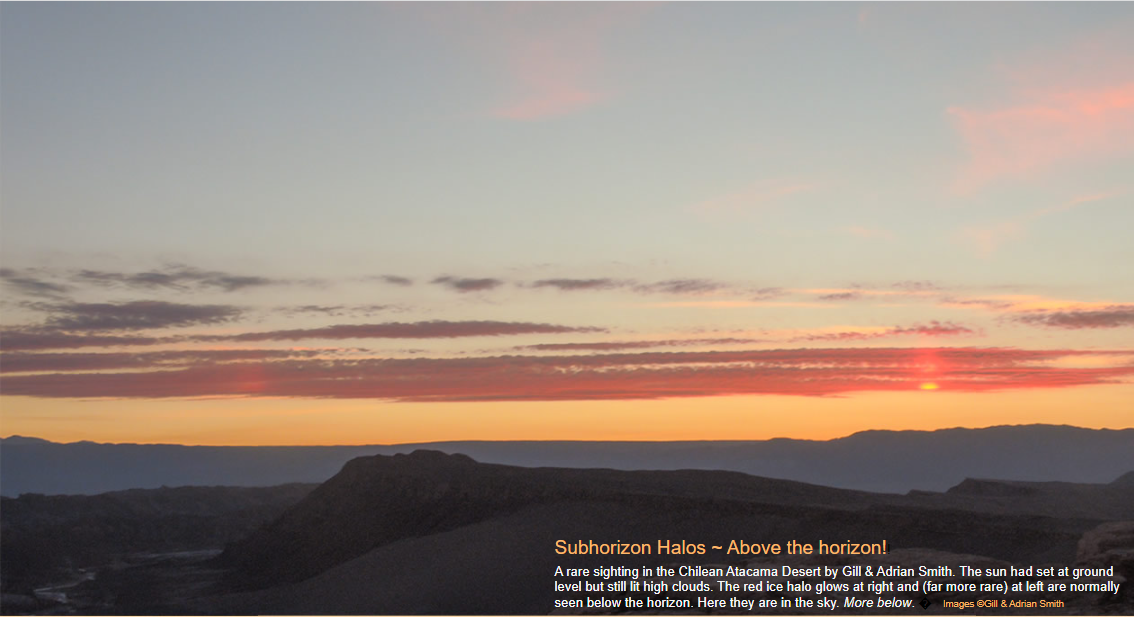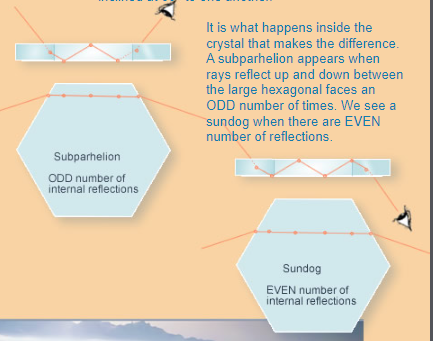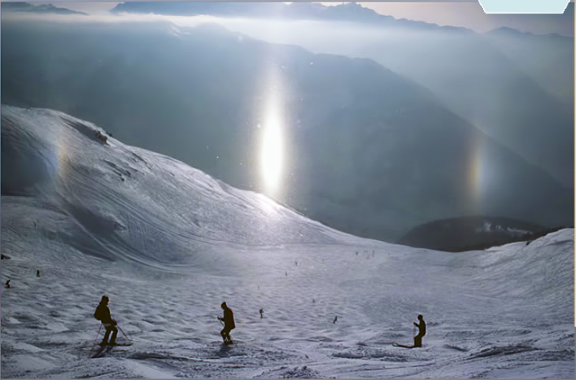Subhorizon halos - Above the horizon - OPOD
Subhorizon Halos: A Rare and Mesmerizing Atmospheric Phenomenon
Have you ever witnessed a truly extraordinary atmospheric optical phenomenon? Picture this: the sun has already set at ground level, but high clouds are still illuminated, creating a captivating display in the sky. In the Chilean Atacama Desert, Gill and Adrian Smith had the privilege of observing a remarkable event - subhorizon halos above the horizon!
Typically, subhorizon halos are seen below the horizon, making their appearance above the horizon an incredibly rare sighting. Gill and Adrian Smith managed to capture this phenomenon through their lens, showcasing the beauty and intricacy of atmospheric optics. The images they captured revealed both a red ice halo glowing on the right and a far more uncommon occurrence on the left.
As the sun sinks lower, parhelia and subparhelia, also known as sundogs, draw closer to each other. Parhelia are bright spots of light that appear on either side of the sun, while subparhelia are their rarer counterparts. When the sun finally sets, these above horizon and subhorizon halos merge, creating a stunning visual spectacle.
But what exactly causes these mesmerizing halos to form? It all comes down to the interaction between sunlight and ice crystals in the atmosphere. Both parhelia and subparhelia are produced when sunlight passes through horizontally aligned ice plate crystals. These crystals have faces inclined at an angle of 60 degrees to one another.
However, it is what happens inside these ice crystals that sets subparhelia apart from their more common counterparts. Subparhelia occur when sunlight reflects up and down between the large hexagonal faces of the ice crystals an odd number of times. On the other hand, we observe sundogs when there are an even number of reflections.
To fully appreciate the beauty of subhorizon halos, let's take a closer look at another example captured by Rob Noble in Verbier, Switzerland. In this image, we can see the familiar sight of a subsun and lower pillar surrounded by prismatic subparhelia, all created by glittering diamond dust. These intricate formations add a touch of magic to the sky, leaving us in awe of nature's wonders.
When encountering such extraordinary atmospheric phenomena, it is essential to investigate and confirm their authenticity. To eliminate the possibility of camera and lens artifacts, it is crucial to observe these apparitions visually and capture them from different angles. This ensures that the position of the halos relative to the sun remains consistent across multiple photographs.
In conclusion, subhorizon halos above the horizon are a captivating and seldom-seen atmospheric optical phenomenon. While they typically manifest below the horizon, their appearance in the sky is a truly remarkable event. Through the lens of photographers like Gill and Adrian Smith and Rob Noble, we are granted a glimpse into the enchanting world of subhorizon halos. These natural wonders remind us of the vast complexity and beauty that surrounds us in the atmosphere above.

Subhorizon Halos ~ Above the horizon!!
A rare sighting in the Chilean Atacama Desert by Gill & Adrian Smith. The sun had set at ground level but still lit high clouds. The red ice halo glows at right and (far more rare) at left are normally seen below the horizon. Here they are in the sky. More below. � Images ©Gill & Adrian Smith

At top the sun is 3° high. Directly below the sun and 3° below the horizon is a subsun and a lower sun pillar. The subsun is flanked by subparhelia.
Parhelia and subparhelia get closer as the sun sinks.
At sunset the above horizon and subhorizon halos merge.
As the sun sinks beneath the local horizon the 'subparhelia' climb into the twilight sky.
HaloSim ray tracings.
The red glow in the clouds at right is a lower sun pillar and subsun. They are directly above the sun which is 3 degrees below the horizon.
The glow at far left at the same height is something much more rare. Indeed it might only have been knowingly photographed a handful of times. It is a subparhelion or sub-sundog.
The subsun and subparhelion are below the horizon when the sun is in the sky. Here the geometry is reversed. The sun is below the horizon and these ice halos project in the sky.
Parhelia and subparhelia are both produced by sun rays passing through horizontally aligned ice plate crystals. The rays enter and leave through faces inclined at 60° to one another.

It is what happens inside the crystal that makes the difference. A subparhelion appears when rays reflect up and down between the large hexagonal faces an ODD number of times. We see a sundog when there are EVEN number of reflections.

The more familiar appearance of subhorizon halos. Here in glittering diamond dust are an intensely bright subsun/lower pillar with prismatic subparhelia on each side.
Imaged by Rob Noble at Verbier, Switzerland.
Unusual apparitions are more worthy of investigation when they are seen visually and appear in the same position relative to the sun on at least two hand camera shots. This helps eliminate the possibility of camera and lens artefacts.
This image made four minutes earlier than the top one again shows at far left the red glow of the subparhelion. Image measurements give the glow 23.6° from the subsun in very reasonable agreement with predictions.

Note: this article has been automatically converted from the old site and may not appear as intended. You can find the original article here.
Reference Atmospheric Optics
If you use any of the definitions, information, or data presented on Atmospheric Optics, please copy the link or reference below to properly credit us as the reference source. Thank you!
-
<a href="https://atoptics.co.uk/blog/subhorizon-halos-above-the-horizon-opod/">Subhorizon halos - Above the horizon - OPOD</a>
-
"Subhorizon halos - Above the horizon - OPOD". Atmospheric Optics. Accessed on April 19, 2024. https://atoptics.co.uk/blog/subhorizon-halos-above-the-horizon-opod/.
-
"Subhorizon halos - Above the horizon - OPOD". Atmospheric Optics, https://atoptics.co.uk/blog/subhorizon-halos-above-the-horizon-opod/. Accessed 19 April, 2024
-
Subhorizon halos - Above the horizon - OPOD. Atmospheric Optics. Retrieved from https://atoptics.co.uk/blog/subhorizon-halos-above-the-horizon-opod/.